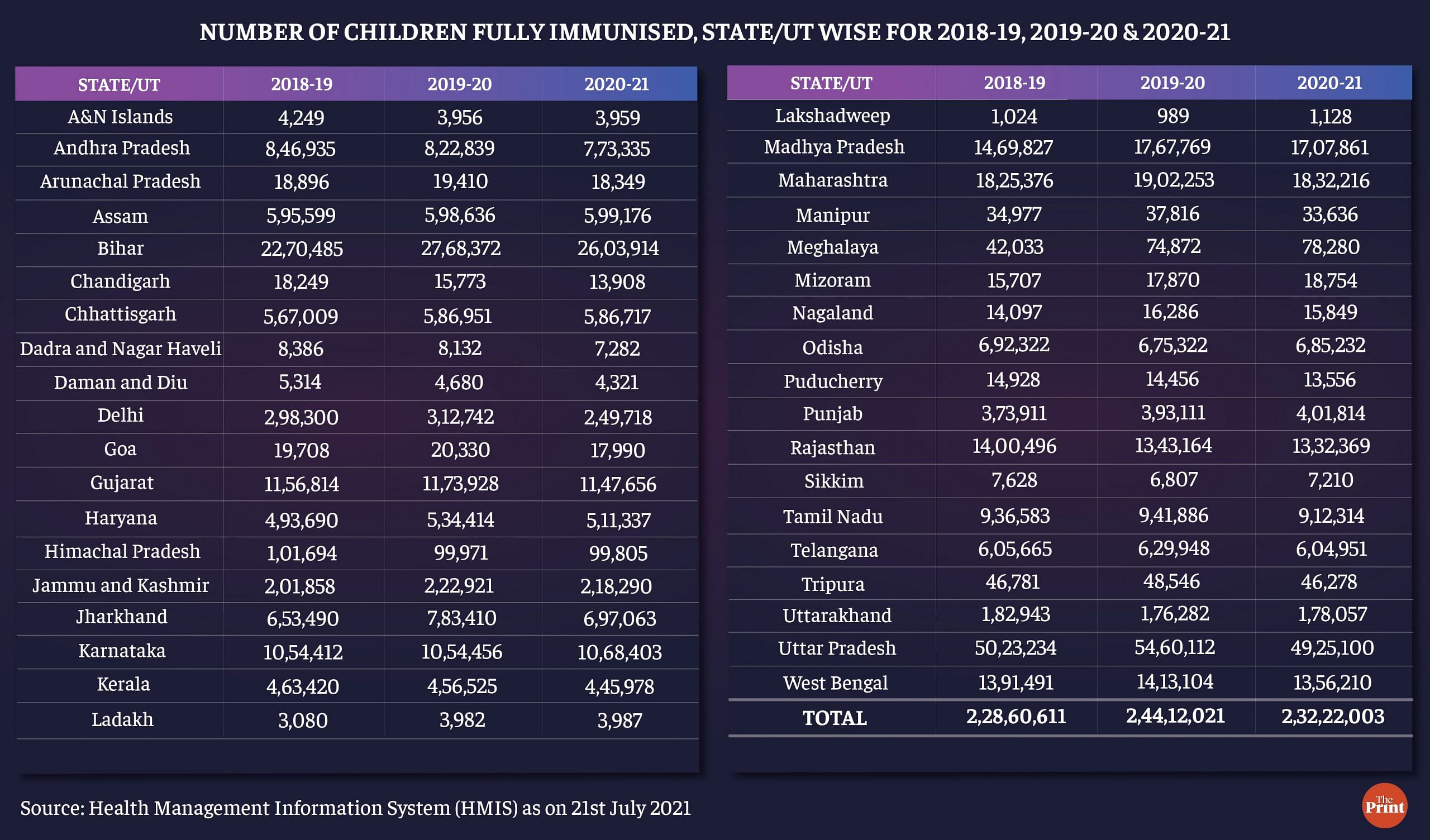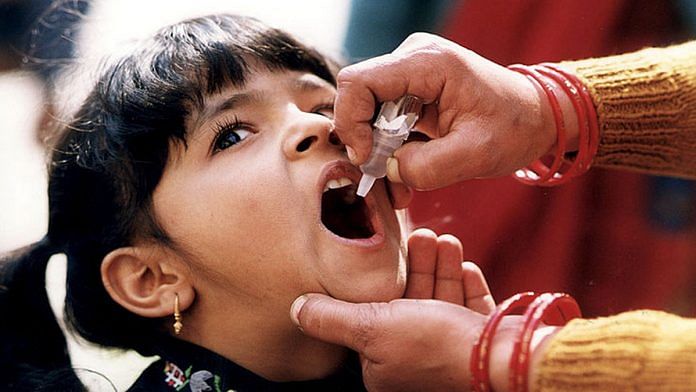New Delhi: India’s routine immunisation of children has suffered a minor setback because of the Covid pandemic. Immunisation coverage, which had touched 92 per cent pre-pandemic, following the launch of Mission Indradhanush (MI) in 2014, is now down by about 5 per cent, according to government data shared in Parliament.
The numbers, however, vary across states. While 2020-21, the first full pandemic year, saw marginal drops in coverage among some of the states worst hit by Covid — including Maharashtra and Kerala — others like Karnataka have recorded higher vaccination numbers than the previous year (2019-20).
Every child in India is entitled to get 12 vaccines within the first year. Even as the Covid vaccine remains the hot topic of conversation, officials say efforts are on to regain lost ground in the routine immunisation drive that helps India guard against such diseases as diphtheria, pertussis, tetanus, polio, measles, rubella, childhood tuberculosis, and hepatitis B.
In reply to a question in the Rajya Sabha Tuesday, the Union Ministry of Health & Family Welfare submitted data that showed 2,32,22,003 (87.9 per cent) children were vaccinated in 2020-2021, as opposed to 2,44,12,021 (92.5 per cent) the year before.
India’s annual birth cohort is estimated at about 2.64 crore babies. Although the number during the pandemic year was still higher than what was achieved in 2018-19 (the last full pre-pandemic year) — about 2,28,60611 — the drop is still a cause for concern.
“We have seen a small dip in vaccination numbers by about 5 per cent, but given that we now have the system in place, we are hopeful of covering that ground soon,” said a senior health ministry official. “It is more difficult to cover uncovered ground and that is what we have been doing through MI.”
Since 2014, when Mission Indradhanush was launched, India’s focus on routine immunisation has resulted in remarkable strides.
By 2019, the coverage had risen to 91 per cent, from 65 per cent when the National Family Health Survey-4 was carried out in 2015-16. Prior to the launch of Indradhanush, India’s annual rate of growth of childhood vaccination was a measly 1 per cent.
Initially designed as a booster programme to address low vaccination numbers in the 201 least vaccinated districts, Mission Indradhanush ushered in a campaign-mode immunisation drive.
The success of the programme — including plaudits for India’s immunisation efforts in the prestigious ‘Pneumonia and Diarrhoea Progress Report’ brought out by the International Vaccine Access Center (IVAC) at the Johns Hopkins Bloomberg School of Public Health — meant that two more editions of the campaign were subsequently launched.
Intensified MI 3.0, conducted in February this year, was targeted at specifically undoing the damage the Covid-19 pandemic has done to the programme.
Also Read: NFHS-5 findings make a case for continued investment in primary healthcare
Differential impact on states
While the overall dip may not be that much, some states were worse affected than others, and the effects were not always in proportion to the local spread of Covid-19.
For example, Maharashtra and Kerala showed a dip in routine immunisation of about 3.6 per cent and 2.3 per cent, respectively.
According to the data that the government submitted in the Rajya Sabha, Maharashtra vaccinated about 70,037 fewer children in the pandemic year than the previous one, while Kerala inoculated 10,547 fewer.

Uttar Pradesh, which showed a dip of about 9.79 per cent, had vaccinated 5,35,012 fewer babies, while Bihar’s numbers fell by 1,64,458 or 5.94 per cent compared to the previous year.
Some states, meanwhile, managed to notch up better numbers in the pandemic year.
Odisha, for example, vaccinated 6,85,232 children in 2020-21, against 6,75,322 the year before, a growth of 9,910. Punjab, which also ranks among the worst-hit Covid states, vaccinated 4,01,814 children in 2020-21, against 3,93,111 the year before, a rise of 8,703. In the same vein, Karnataka vaccinated 10,68,403 children in 2020-21, against 10,54,546 the year before, a difference of 13,857.
Polio coverage down
In 2014, India won global praise for having managed to eradicate polio. However, the pandemic has also affected the coverage of the polio vaccine, which is among India’s best.
In a separate reply in the Lok Sabha, Minister of State for Health Bharti Praveen Pawar said: “As per the World Health Organization (WHO) and United Nations Children’s Fund (UNICEF) estimates, India’s coverage of third dose of Oral Polio Vaccine (OPV) vaccine was 90 per cent in 2019 and 85 per cent in 2020.”
She also outlined the steps being taken to recover lost ground. “Appropriate communication material has been developed and shared with the states and UTs for addressing vaccine hesitancy and strengthening routine immunisation with due precautions, during Covid-19 pandemic,” she said.
“Supply chain of vaccines and other logistics has been ensured during Covid-19 pandemic. In addition, Intensified Mission Indradhanush 3.0 was also conducted in February 2021 and March 2021, to cover the unvaccinated and partially vaccinated children. These efforts have contributed in reduction of immunisation gap coverage. States/UTs have been asked to prepare specific plans to improve full immunisation coverage and to ensure designated days in a week only for routine immunisation activity,” Pawar said in her written reply.
(Edited by Sunanda Ranjan)
Also Read: India boosts child vaccinations but lags in access to pneumonia & diarrhoea treatment — report



